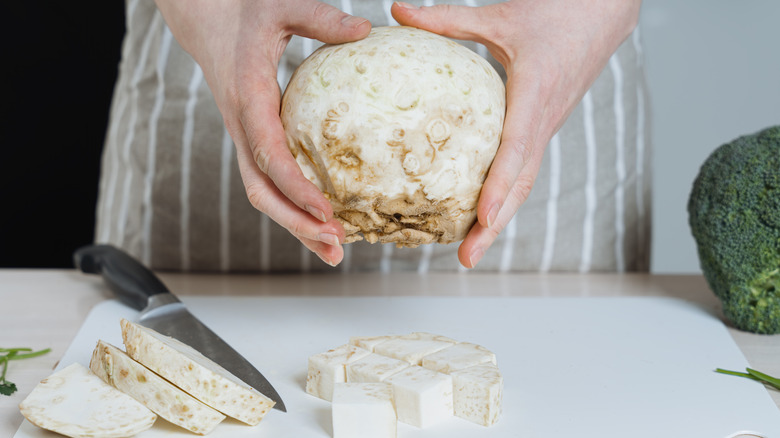The Low-Carb Root Vegetable That Can Prevent Diabetes, Cancer, And Blood Clots At The Same Time
You're nosing around your farmer's market in the fall when you spot it: a root vegetable that you don't recognize. It looks kind of like a misshapen, gnarled turnip with protruding leaves, and its name reminds you of a familiar crunchy snack, celery. You wonder what it is, as well as whether or not it's worth a taste test. The veggie in question is celeriac, and it absolutely belongs on your menu rotation due to its impressive nutritional profile and accompanying health benefits.
The name is a bit of a giveaway that it's related to celery. (Side note: It comes from the apiaceae family of vegetables, alongside carrots, celery, and parsley.) However, its standard root vegetable flesh has less of a celery overtone and tastes a little closer to a parsnip. But it's the nutrient background of celeriac — and not its looks — that will earn your praise. A 100-gram serving of raw celeriac contains 1.8 grams of fiber, 1.5 grams of protein, 9.2 grams of carbohydrates, and a significant amount of vitamins C and K. Plus, celeriac offers antioxidant compounds, making it an all-around healthy, low-calorie, low-carb, and low-fat food.
What can you expect celeriac to do for your body if you start eating it as part of a balanced meal plan? You may find that it's helpful in controlling your blood sugars, reducing your risk of some cancers, and preventing unwanted blood clots with food.
How celeriac can help with blood sugar management
Although eating foods to reduce high blood sugar levels is more important to individuals with diabetes, you may want to stabilize your sugar readings by eating blood sugar-friendly veggies even if you're not diabetic. A sudden sugar spike can cause anyone — including people with normal metabolisms — to experience unwanted side effects like thirst and tiredness. And there seems to be a connection between the development of diabetes and uncontrolled blood sugar. Eating fatty, processed foods (which frequently contain added sugars) can contribute to insulin resistance, which can lead to diabetes.
The fiber in celeriac enables it to assist your gastrointestinal system in processing sugars at a slower pace. Plant-based forms of fiber stretch out the digestion and absorption of sugars. This keeps your blood sugar in check because sugar isn't being metabolized immediately. However, you should know that if you cook celeriac before eating it, you'll end up eating one-third less fiber than if you eat the same amount fresh: 100 grams of cooked celeriac only has 1.2 grams of fiber.
That said, the fiber in celeriac alone won't keep you from getting diabetes. But it could bring down your chances of diabetes or, if you already have diabetes, could offer an all-natural way to control your sugars.
The anti-cancer potential of celeriac
Consuming this odd-looking super veggie may also help you lower your cancer risk due to its antioxidant content. Research shows that antioxidants can protect against cellular damage caused by oxidative stress. The less damage your cells incur, the lower the likelihood they'll succumb to cancerous changes.
Vitamin K may contribute to the anticancer properties of celeriac, too. For example, a 2006 study in the International Journal of Molecular Medicine showed that vitamin K supplementation encouraged the death of gastric cancer cells in test tubes. Similarly, a 2007 study in the International Journal of Oncology reported that when mice with colorectal cancer were given vitamin K, their tumor growth was arrested.
A final upside to incorporating more celeriac into your weekly food rotation is that it is useful in maintaining normal blood clotting. That said, talk with your doctor about adding vitamin K through foods or supplements if you're taking a blood thinner, as vitamin K can interfere with the effectiveness of those kinds of medications.


